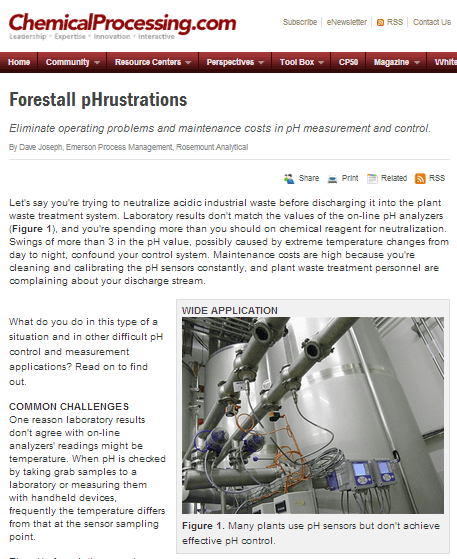 I know from listening to some of Control Talk blog’s Greg McMillan’s presentations on pH control what a difficult control challenge this can be. Chemical Processing magazine has a great article, Forestall pHrustrations, by Emerson’s Dave Joseph that shares ways to avoid problems and improve pH measurement and control. “Bad” pH control wastes chemicals and “bad” measurement requires additional maintenance to correct problems.
I know from listening to some of Control Talk blog’s Greg McMillan’s presentations on pH control what a difficult control challenge this can be. Chemical Processing magazine has a great article, Forestall pHrustrations, by Emerson’s Dave Joseph that shares ways to avoid problems and improve pH measurement and control. “Bad” pH control wastes chemicals and “bad” measurement requires additional maintenance to correct problems.
I’ll highlight a few tips from which there were many to choose and strongly encourage you to read the article if pH measurement and control is a part of your responsibilities.
Dave notes that temperature differences can play a role in pH differences between on-line pH sensors and grab samples taken into the lab for analysis. He explains:
Any solution with a pH of 7 or above will show some degree of temperature dependence. How much depends on the composition of the solution and the process temperature extremes.
When neutralizing a solution, the temperature also impacts the amount of reagent required. He shared a soap manufacturer’s circumstances where ten times as much reagent was required at 60°C as was required at 25°C. Dave highlights why this is the case:
Water’s dissociation constant is much higher at 60°C. The reagent appears less effective because there’s more hydroxide ion to neutralize at the elevated temperature. Temperature and nonlinearity are common causes of overshoot in pH control. A bad sensor location or not enough holdup time also can prompt overshoot problems.
Placement of the online analyzers is very important:
If the reaction tank is large and the pH sensor is located far from the reagent dosing point, it can take a long time for the sensor to detect the change. The sensor will continue to call for reagent long after enough has been added to achieve neutralization. This leads to overshoot and oscillation, a pH value higher or lower than desired, and wasted reagent.
On what can impact pH sensors:
The two biggest mechanical challenges facing pH sensors are temperature extremes, which can crack the glass sensor, and process fluids that coat or poison the sensor elements.
Depending on the application process conditions, pH sensors come in many varieties to deal with these conditions. Most plants don’t have a pH expert available full time on staff. In order to match the right pH sensor with the process conditions, Dave summarizes his advice:
…to use plant personnel’s deep understanding of the process and the marketplace to select the right partner, and to work together to choose the correct sensor for the particular application.
This is just a smattering of the tips shared, so check out the article if you are or will be involved with pH measurement and control.
